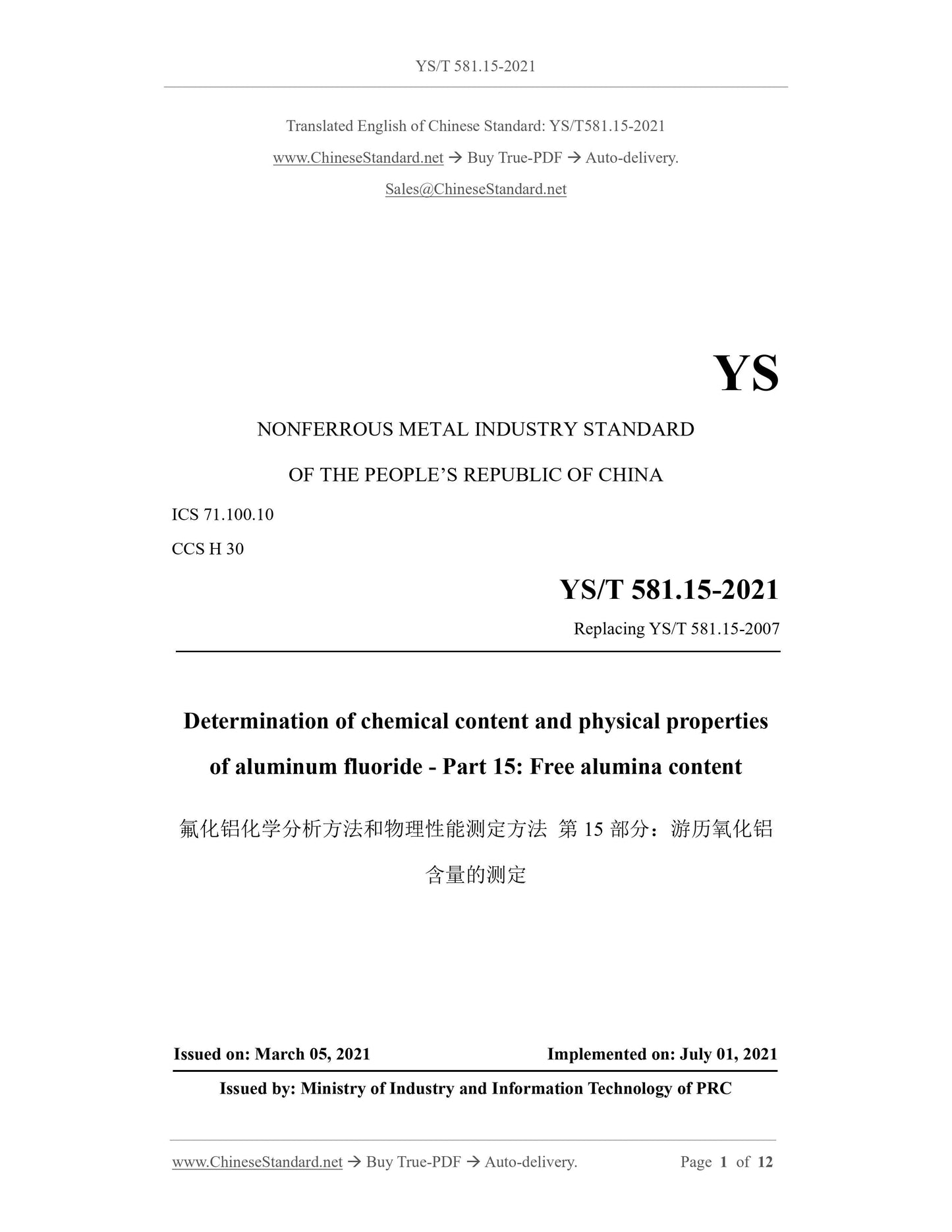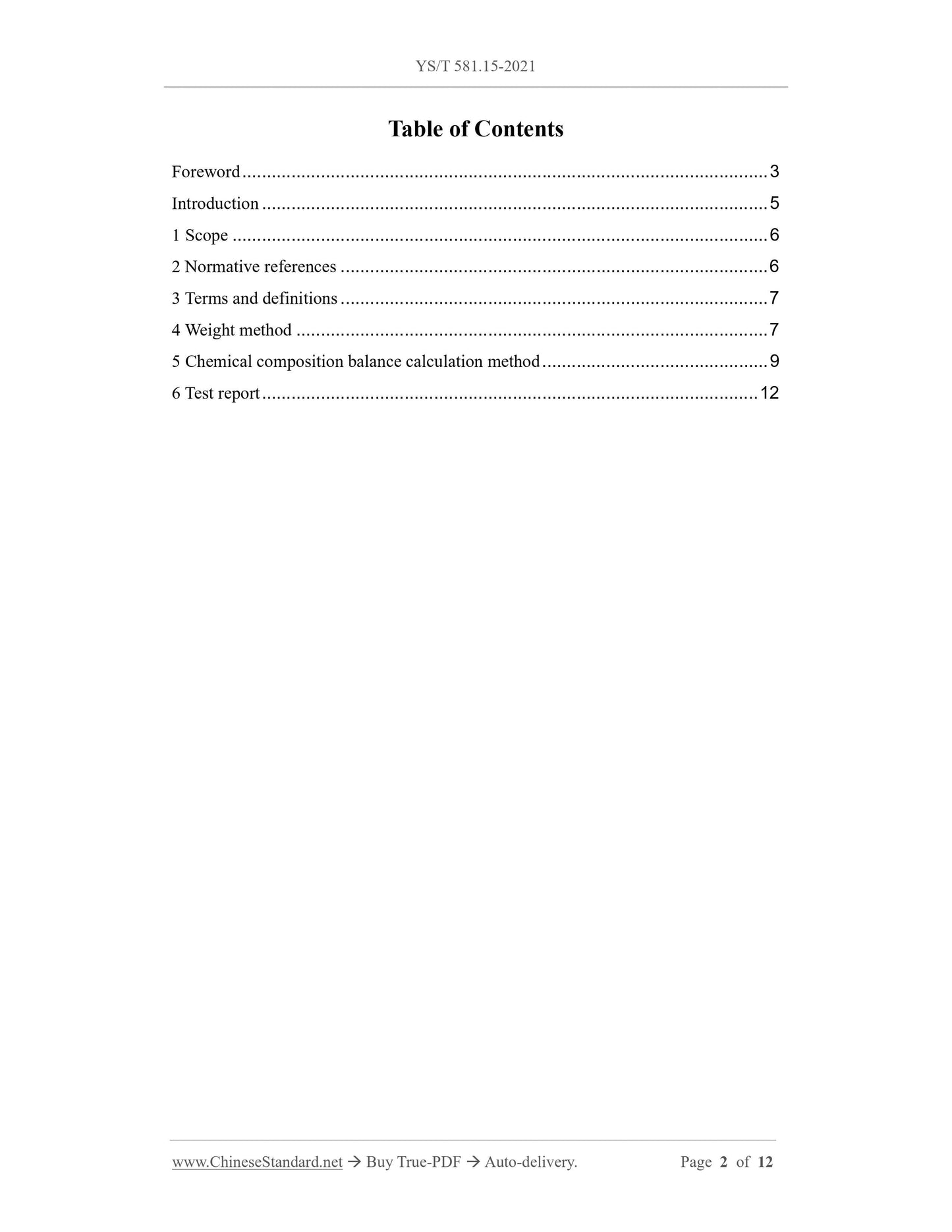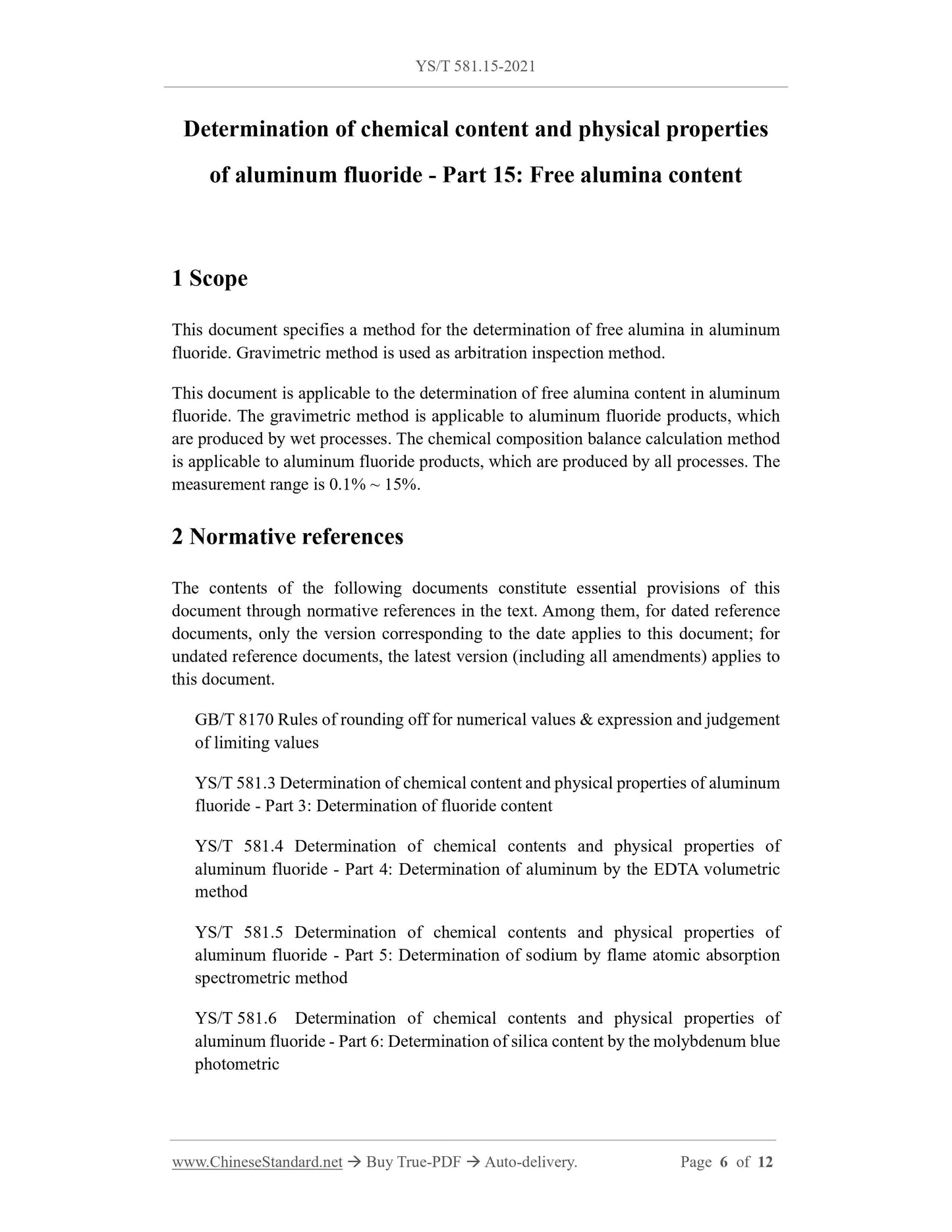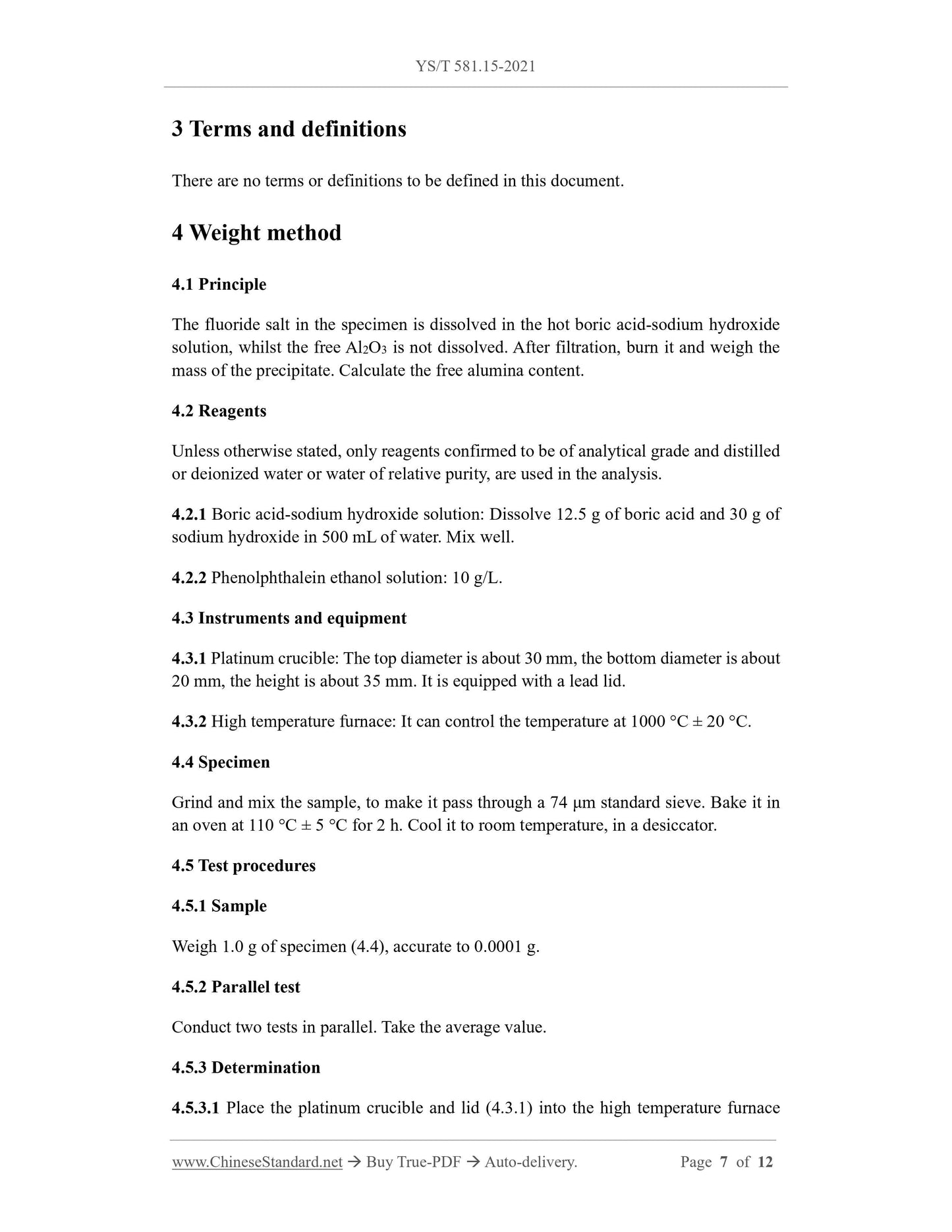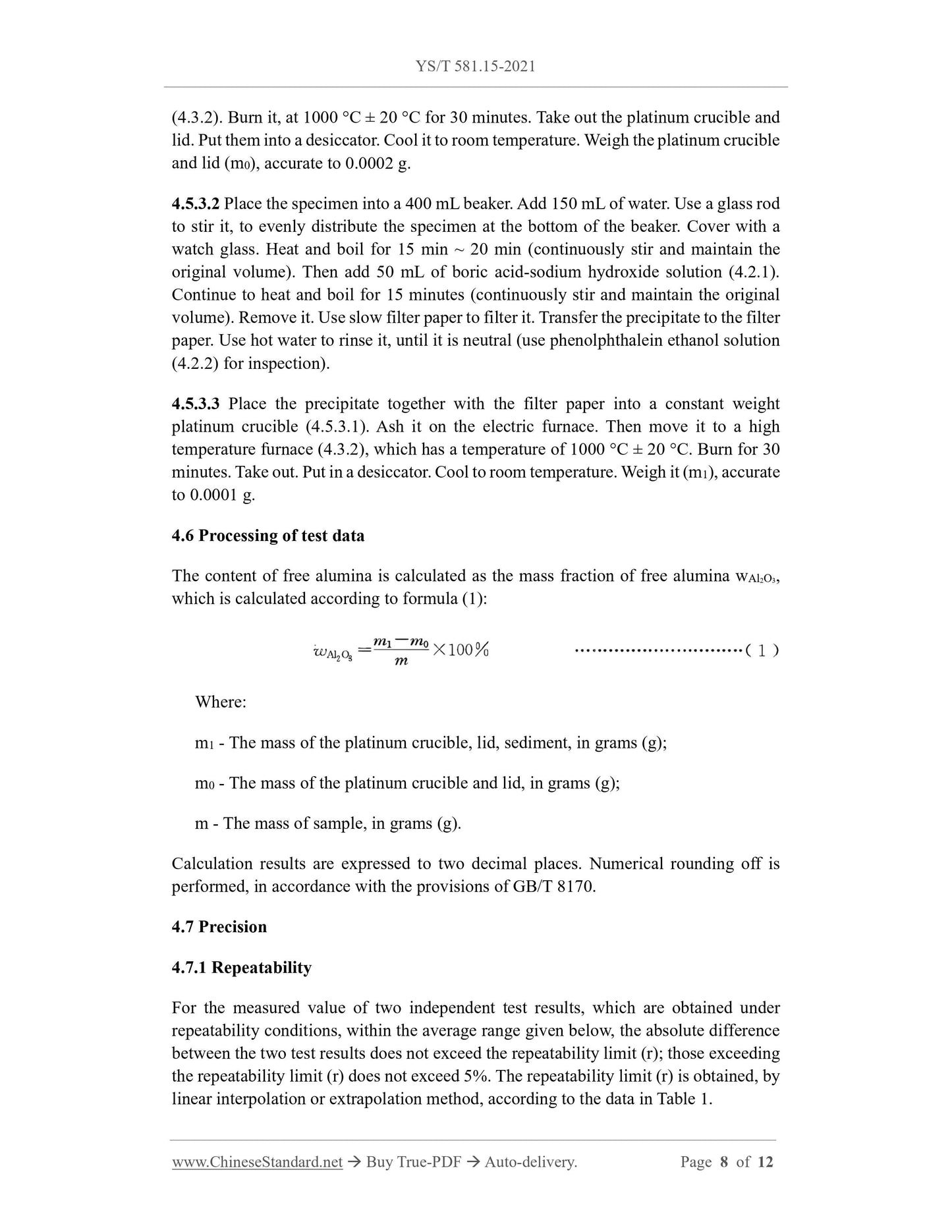1
/
/
5
PayPal, credit cards. Download editable-PDF and invoice in 1 second!
YS/T 581.15-2021 English PDF (YST581.15-2021)
YS/T 581.15-2021 English PDF (YST581.15-2021)
Normaalihinta
$185.00 USD
Normaalihinta
Alennushinta
$185.00 USD
Yksikköhinta
/
kohti
Toimituskulut lasketaan kassalla.
Noudon saatavuutta ei voitu ladata
Delivery: 3 seconds. Download true-PDF + Invoice.
Get QUOTATION in 1-minute: Click YS/T 581.15-2021
Historical versions: YS/T 581.15-2021
Preview True-PDF (Reload/Scroll if blank)
YS/T 581.15-2021: Determination of chemical content and physical properties of aluminium fluoride - Part 15: Free alumina content
YS/T 581.15-2021
YS
NONFERROUS METAL INDUSTRY STANDARD
OF THE PEOPLE’S REPUBLIC OF CHINA
ICS 71.100.10
CCS H 30
Replacing YS/T 581.15-2007
Determination of chemical content and physical properties
of aluminum fluoride - Part 15: Free alumina content
ISSUED ON: MARCH 05, 2021
IMPLEMENTED ON: JULY 01, 2021
Issued by: Ministry of Industry and Information Technology of PRC
Table of Contents
Foreword ... 3
Introduction ... 5
1 Scope ... 6
2 Normative references ... 6
3 Terms and definitions ... 7
4 Weight method ... 7
5 Chemical composition balance calculation method ... 9
6 Test report ... 12
Determination of chemical content and physical properties
of aluminum fluoride - Part 15: Free alumina content
1 Scope
This document specifies a method for the determination of free alumina in aluminum
fluoride. Gravimetric method is used as arbitration inspection method.
This document is applicable to the determination of free alumina content in aluminum
fluoride. The gravimetric method is applicable to aluminum fluoride products, which
are produced by wet processes. The chemical composition balance calculation method
is applicable to aluminum fluoride products, which are produced by all processes. The
measurement range is 0.1% ~ 15%.
2 Normative references
The contents of the following documents constitute essential provisions of this
document through normative references in the text. Among them, for dated reference
documents, only the version corresponding to the date applies to this document; for
undated reference documents, the latest version (including all amendments) applies to
this document.
GB/T 8170 Rules of rounding off for numerical values and expression and judgement
of limiting values
YS/T 581.3 Determination of chemical content and physical properties of aluminum
fluoride - Part 3: Determination of fluoride content
YS/T 581.4 Determination of chemical contents and physical properties of
aluminum fluoride - Part 4: Determination of aluminum by the EDTA volumetric
method
YS/T 581.5 Determination of chemical contents and physical properties of
aluminum fluoride - Part 5: Determination of sodium by flame atomic absorption
spectrometric method
YS/T 581.6 Determination of chemical contents and physical properties of
aluminum fluoride - Part 6: Determination of silica content by the molybdenum blue
photometric
3 Terms and definitions
There are no terms or definitions to be defined in this document.
4 Weight method
4.1 Principle
The fluoride salt in the specimen is dissolved in the hot boric acid-sodium hydroxide
solution, whilst the free Al2O3 is not dissolved. After filtration, burn it and weigh the
mass of the precipitate. Calculate the free alumina content.
4.2 Reagents
Unless otherwise stated, only reagents confirmed to be of analytical grade and distilled
or deionized water or water of relative purity, are used in the analysis.
4.2.1 Boric acid-sodium hydroxide solution: Dissolve 12.5 g of boric acid and 30 g of
sodium hydroxide in 500 mL of water. Mix well.
4.2.2 Phenolphthalein ethanol solution: 10 g/L.
4.3 Instruments and equipment
4.3.1 Platinum crucible: The top diameter is about 30 mm, the bottom diameter is about
20 mm, the height is about 35 mm. It is equipped with a lead lid.
4.3.2 High temperature furnace: It can control the temperature at 1000 °C ± 20 °C.
4.4 Specimen
Grind and mix the sample, to make it pass through a 74 μm standard sieve. Bake it in
an oven at 110 °C ± 5 °C for 2 h. Cool it to room temperature, in a desiccator.
4.5 Test procedures
4.5.1 Sample
Weigh 1.0 g of specimen (4.4), accurate to 0.0001 g.
4.5.2 Parallel test
Conduct two tests in parallel. Take the average value.
4.5.3 Determination
4.5.3.1 Place the platinum crucible and lid (4.3.1) into the high temperature furnace
(4.3.2). Burn it, at 1000 °C ± 20 °C for 30 minutes. Take out the platinum crucible and
lid. Put them into a desiccator. Cool it to room temperature. Weigh the platinum crucible
and lid (m0), accurate to 0.0002 g.
4.5.3.2 Place the specimen into a 400 mL beaker. Add 150 mL of water. Use a glass rod
to stir it, to evenly distribute the specimen at the bottom of the beaker. Cover with a
watch glass. Heat and boil for 15 min ~ 20 min (continuously stir and maintain the
original volume). Then add 50 mL of boric acid-sodium hydroxide solution (4.2.1).
Continue to heat and boil for 15 minutes (continuously stir and maintain the original
volume). Remove it. Use slow filter paper to filter it. Transfer the precipitate to the filter
paper. Use hot water to rinse it, until it is neutral (use phenolphthalein ethanol solution
(4.2.2) for inspection).
4.5.3.3 Place the precipitate together with the filter paper into a constant weight
platinum crucible (4.5.3.1). Ash it on the electric furnace. Then move it to a high
temperature furnace (4.3.2), which has a temperature of 1000 °C ± 20 °C. Burn for 30
minutes. Take out. Put in a desiccator. Cool to room temperature. Weigh it (m1), accurate
to 0.0001 g.
4.6 Processing of test data
The content of free alumina is calculated as the mass fraction of free alumina wAl2O3,
which is calculated according to formula (1):
Where:
m1 - The mass of the platinum crucible, lid, sediment, in grams (g);
m0 - The mass of the platinum crucible and lid, in grams (g);
m - The mass of sample, in grams (g).
Calculation results are expressed to two decimal places. Numerical rounding off is
performed, in accordance with the provisions of GB/T 8170.
4.7 Precision
4.7.1 Repeatability
For the measured value of two independent test results, which are obtained under
repeatability conditions, within the average range given below, the absolute difference
between the two test results does not exceed the repeatability limit (r); those exceeding
the repeatability limit (r) does not exceed 5%. The repeatability limit (r) is obtained, by
linear interpolation or extrapolation method, according to the data in Table 1.
Get QUOTATION in 1-minute: Click YS/T 581.15-2021
Historical versions: YS/T 581.15-2021
Preview True-PDF (Reload/Scroll if blank)
YS/T 581.15-2021: Determination of chemical content and physical properties of aluminium fluoride - Part 15: Free alumina content
YS/T 581.15-2021
YS
NONFERROUS METAL INDUSTRY STANDARD
OF THE PEOPLE’S REPUBLIC OF CHINA
ICS 71.100.10
CCS H 30
Replacing YS/T 581.15-2007
Determination of chemical content and physical properties
of aluminum fluoride - Part 15: Free alumina content
ISSUED ON: MARCH 05, 2021
IMPLEMENTED ON: JULY 01, 2021
Issued by: Ministry of Industry and Information Technology of PRC
Table of Contents
Foreword ... 3
Introduction ... 5
1 Scope ... 6
2 Normative references ... 6
3 Terms and definitions ... 7
4 Weight method ... 7
5 Chemical composition balance calculation method ... 9
6 Test report ... 12
Determination of chemical content and physical properties
of aluminum fluoride - Part 15: Free alumina content
1 Scope
This document specifies a method for the determination of free alumina in aluminum
fluoride. Gravimetric method is used as arbitration inspection method.
This document is applicable to the determination of free alumina content in aluminum
fluoride. The gravimetric method is applicable to aluminum fluoride products, which
are produced by wet processes. The chemical composition balance calculation method
is applicable to aluminum fluoride products, which are produced by all processes. The
measurement range is 0.1% ~ 15%.
2 Normative references
The contents of the following documents constitute essential provisions of this
document through normative references in the text. Among them, for dated reference
documents, only the version corresponding to the date applies to this document; for
undated reference documents, the latest version (including all amendments) applies to
this document.
GB/T 8170 Rules of rounding off for numerical values and expression and judgement
of limiting values
YS/T 581.3 Determination of chemical content and physical properties of aluminum
fluoride - Part 3: Determination of fluoride content
YS/T 581.4 Determination of chemical contents and physical properties of
aluminum fluoride - Part 4: Determination of aluminum by the EDTA volumetric
method
YS/T 581.5 Determination of chemical contents and physical properties of
aluminum fluoride - Part 5: Determination of sodium by flame atomic absorption
spectrometric method
YS/T 581.6 Determination of chemical contents and physical properties of
aluminum fluoride - Part 6: Determination of silica content by the molybdenum blue
photometric
3 Terms and definitions
There are no terms or definitions to be defined in this document.
4 Weight method
4.1 Principle
The fluoride salt in the specimen is dissolved in the hot boric acid-sodium hydroxide
solution, whilst the free Al2O3 is not dissolved. After filtration, burn it and weigh the
mass of the precipitate. Calculate the free alumina content.
4.2 Reagents
Unless otherwise stated, only reagents confirmed to be of analytical grade and distilled
or deionized water or water of relative purity, are used in the analysis.
4.2.1 Boric acid-sodium hydroxide solution: Dissolve 12.5 g of boric acid and 30 g of
sodium hydroxide in 500 mL of water. Mix well.
4.2.2 Phenolphthalein ethanol solution: 10 g/L.
4.3 Instruments and equipment
4.3.1 Platinum crucible: The top diameter is about 30 mm, the bottom diameter is about
20 mm, the height is about 35 mm. It is equipped with a lead lid.
4.3.2 High temperature furnace: It can control the temperature at 1000 °C ± 20 °C.
4.4 Specimen
Grind and mix the sample, to make it pass through a 74 μm standard sieve. Bake it in
an oven at 110 °C ± 5 °C for 2 h. Cool it to room temperature, in a desiccator.
4.5 Test procedures
4.5.1 Sample
Weigh 1.0 g of specimen (4.4), accurate to 0.0001 g.
4.5.2 Parallel test
Conduct two tests in parallel. Take the average value.
4.5.3 Determination
4.5.3.1 Place the platinum crucible and lid (4.3.1) into the high temperature furnace
(4.3.2). Burn it, at 1000 °C ± 20 °C for 30 minutes. Take out the platinum crucible and
lid. Put them into a desiccator. Cool it to room temperature. Weigh the platinum crucible
and lid (m0), accurate to 0.0002 g.
4.5.3.2 Place the specimen into a 400 mL beaker. Add 150 mL of water. Use a glass rod
to stir it, to evenly distribute the specimen at the bottom of the beaker. Cover with a
watch glass. Heat and boil for 15 min ~ 20 min (continuously stir and maintain the
original volume). Then add 50 mL of boric acid-sodium hydroxide solution (4.2.1).
Continue to heat and boil for 15 minutes (continuously stir and maintain the original
volume). Remove it. Use slow filter paper to filter it. Transfer the precipitate to the filter
paper. Use hot water to rinse it, until it is neutral (use phenolphthalein ethanol solution
(4.2.2) for inspection).
4.5.3.3 Place the precipitate together with the filter paper into a constant weight
platinum crucible (4.5.3.1). Ash it on the electric furnace. Then move it to a high
temperature furnace (4.3.2), which has a temperature of 1000 °C ± 20 °C. Burn for 30
minutes. Take out. Put in a desiccator. Cool to room temperature. Weigh it (m1), accurate
to 0.0001 g.
4.6 Processing of test data
The content of free alumina is calculated as the mass fraction of free alumina wAl2O3,
which is calculated according to formula (1):
Where:
m1 - The mass of the platinum crucible, lid, sediment, in grams (g);
m0 - The mass of the platinum crucible and lid, in grams (g);
m - The mass of sample, in grams (g).
Calculation results are expressed to two decimal places. Numerical rounding off is
performed, in accordance with the provisions of GB/T 8170.
4.7 Precision
4.7.1 Repeatability
For the measured value of two independent test results, which are obtained under
repeatability conditions, within the average range given below, the absolute difference
between the two test results does not exceed the repeatability limit (r); those exceeding
the repeatability limit (r) does not exceed 5%. The repeatability limit (r) is obtained, by
linear interpolation or extrapolation method, according to the data in Table 1.
Share
